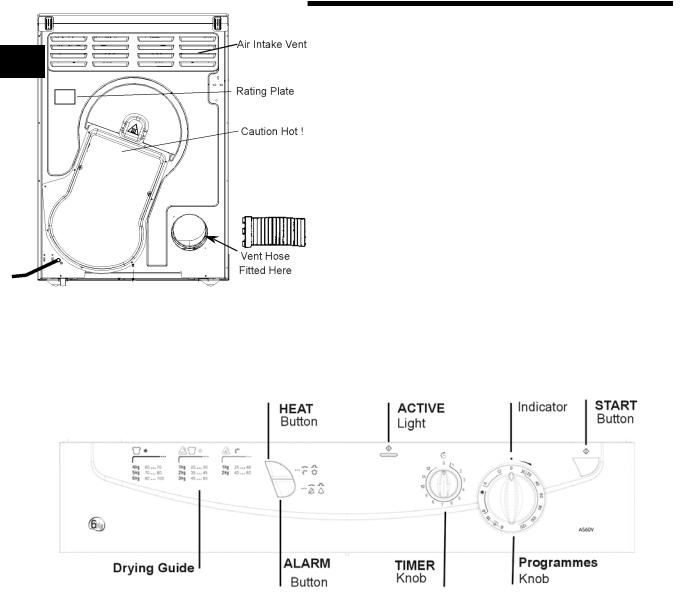Ariston AS60V User Manual

19504259100 English |
{PDF Created 13/11/04 12:27} |
Instruction booklet
TUMBLE DRYER
Contents
Installation, 2-3
Where to put your dryer Ventilation
Electrical connection
Before you start using your dryer
Dryer Description, 4-5
The front
The back
Control panel
Start and Programmes, 6-7
Choosing a Programme
Table of Programmes
Laundry, 5-9
Sorting your laundry
Wash care labels
Special clothing items
Drying times
Warnings and Suggestions, 10
General safety Disposal
Save energy and respect the environment
Maintenance and Care, 11
Switching off the electricity Clean the filter after each cycle
Check the drum after each cycle
Cleaning the dryer
AS60V
Troubleshooting, 12
Service, 13
Spare parts

19504259100 English |
{PDF Created 13/11/04 12:27} |
Installation
TD4001 Issue 1
GB |
! Keep this instruction booklet on hand in order to refer |
|
to it when necessary. Take it with you when you move, |
||
|
||
|
and, should you sell this appliance or pass it on to |
|
|
||
|
another party, make sure that this booklet is supplied |
|
|
along with the dryer so that the new owner may be |
|
|
informed about warnings and suggestions on how the |
|
|
dryer works. |
|
|
! Read these instructions carefully; the following |
|
|
pages contain important information on installation |
|
|
and suggestions on how the appliance works. |
Where to put your dryer
•Place your dryer at a distance from gas ranges, stoves, heaters, or cook tops because flames can damage the appliance.
•If you are going to install the appliance under a work counter, be sure to leave a 10 mm space between the top and any other objects on or above the machine and a 15 mm space between the sides and lateral furnishings or walls. This is to ensure proper air circulation. Make sure that the back vents are not obstructed.
•Make sure you put your dryer in an environment that is not damp and has proper air circulation throughout.
Ventilation
This Dryer dries your laundry by drawing in cool, clean and relatively dry air, heating it, and then distributing it through the clothes as they are gently tumbled. For optimum performance, the moist air is then blown out through a vent tube behind the dryer. When the dryer is in use, there has to be adequate ventilation to avoid a back flow of gases into the room from appliances burning other fuels, including open fires.
Mobile venting
A vent tube must always be fitted when the dryer is used in conjunction with Mobile venting. The tube must be fitted securely into the back of the dryer (see Dryer Description). If possible, it is always best to connect the tube to a permanent vent close to the dryer. If permanent installation is not possible, the dryer will work just as well with the tube passing through a partly-opened window.
!Ensure that the end of the tube is not directed toward the air intake vent at the rear of the dryer.
!The vent tube should not exceed 2,4 m in length, and should be kept free of any possible accumulation of fluff, lint, and water by shaking it out frequently. Always ensure that the tube is not squashed.
Permanent venting
In conjunction with the vent tube we recommend using a Wall/Window Vent Kit, available at a retail location or the nearest Spare Parts Dealer:
Wall mounting
1. Leave an opening in the wall to the left of dryer’s intended position. 2. Keep the tube as short and straight as possible to prevent condensed moisture from backing up into the dryer.
3. Similarly, the duct in the wall should slope downwards towards the outside.
Window mounting
1. With a stacked dryer the hole in the window should ideally be made below the vent.
2. The tube should be kept as short as possible.
Depending upon how often you use your dryer, it is essential that areas A and B are checked periodically to remove lint or debris. The vent tube adaptor must be fitted securely thus preventing any humid air from being emitted back into the room.
!The Dryer should not be pushed so far back that the tube adaptor is pulled out of position or the tube is squashed or bent.
!The tube should be kept clear of the air intake vent and kinks or ‘U’ bends must be avoided as these will obstruct the tube and trap condensation.

19504259100 English |
{PDF Created 13/11/04 12:27} |
Open window venting
The end of the tube should be directed downwards to prevent warm and moist air from condensing in the room or in the dryer.
!Ensure that the dryer is adequately ventilated and that the end of the vent tube is not directed towards the air intake duct.
!The vent tube must always be fitted for optimum performance.
!Make sure that the vent tube and air intake vents are not obstructed or blocked.
!The dryer must not recycle exhaust air.
!Misusing a tumble dryer may create a fire hazard.
!Do not discharge exhaust air into a flue which is used for exhaust fumes from other appliances that burn gas or other fuels.
!Do not use extension cords
!The power cord must not be bent or squashed.
! The power cord should be checked periodically and |
GB |
replaced by a cord specially prepared for this dryer |
|
and fitted only by authorised technicians. (see |
|
Service). New or longer power cords are supplied at |
|
an extra charge by authorised dealers. |
|
!Ensure that any portable outlet or extension lead is positioned so that it is not subjected to any splashing or ingress of moistures
!The manufacturer denies any responsibility should any of these rules not be followed.
!If in doubt about any of the above consult a qualified electrician
Before you start using your dryer
Once you’ve installed your dryer and before you use it, clean the inside of the drum to remove any dust that could have accumulated during transportation.
Electrical connection
Make sure of the following before you insert the plug into the electrical socket:
•The socket must be grounded.
•The socket must be able to sustain the machine’s maximum power, which is indicated on the rating label (see Dryer Description).
•Power voltage must be within the values indicated on the rating label (see Dryer Description).
•The socket must be compatible with the dryer’s plug. Should this not be the case, replace the plug or the socket.
!The dryer must not be installed outdoors, even if the space is sheltered. It can be very dangerous if exposed to rain or storms.
!Once installed, the dryer’s electrical wire and plug must be within reach.
TD4002AUS Issue 1

19504259100 English |
{PDF Created 13/11/04 12:27} |
Dryer Description
TD4010 Issue 1
The front
GB
Control Panel
The START button begins drying a selected programme (see Start and Programmes).
The HEAT button selects drying temperature
(see Start and Programmes). Out: HIGH heat. In: LOW heat.
The ALARM buzzer signals the end of a drying cycle. OUT: buzzer On. IN: buzzer Off.
The ACTIVE indicator light signals that your dryer is in use. This light will glow when the start switch is pressed. It will remain on until the door is opened or the power is turned off. This light will be on during a delayed start programme.
The back
The Drying Guide allows you to consult a user friendly table of fabric types and load capacities.
The TIMER knob sets a delay on the dryer’s start time. Rotate it clockwise until you reach the number of hours you want to delay the start time. If you’ve gone too far, turn the knob counter-clockwise (see Start and Programmes).
The PROGRAMMES knob sets the programme: rotate it clockwise, never counter-clockwise, until the indicator is pointing to the programme you want to select (see Start and Programmes).
